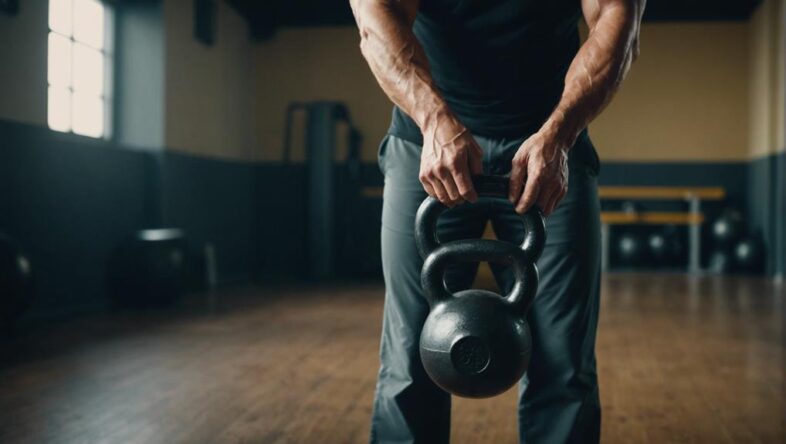You'll get a full-body workout and build functional strength with standing kettlebell ab exercises that target your core, obliques, and stabilizer muscles. Mastering fundamental kettlebell exercises is key, as they form the foundation of a standing kettlebell core workout. By engaging your transverse abdominis, hip flexors, and erector spinae muscles, you'll build core endurance and stability. Effective exercises like kettlebell halos, windmills, and marches challenge your core strength and stability. As you progress, you'll discover more dynamic moves and workout routines to take your core strength to the next level.
Key Takeaways
- Mastering standing kettlebell core exercises targets abs, obliques, and stabilizer muscles, including transverse abdominis, hip flexors, and erector spinae muscles.
- Standing core moves engage shoulders, arms, back, and legs, providing a full-body workout that can be completed in as little as 15-20 minutes.
- Effective standing kettlebell ab exercises include kettlebell halo, windmill, and suitcase march, which target obliques, hip flexors, and erector spinae muscles.
- Dynamic standing kettlebell moves, such as windmills and halos, harness rotational movements to challenge core stability and generate explosive strength.
- Performing EMOM (every minute on the minute) x 3 rounds with exercises like kettlebell marches, halos, windmills, and hand-to-hand passes provides a comprehensive core workout.
Essential Kettlebell Exercises
To begin building a strong, stable core, focus on mastering the fundamental kettlebell exercises that target your abs, obliques, and stabilizer muscles, including the transverse abdominis, hip flexors, and erector spinae muscles.
These essential exercises will form the foundation of your standing kettlebell core workout, providing a full-body training experience. You'll engage your shoulders, arms, back, and legs while developing strength, stability, and mobility.
The exercises, such as kettlebell marches, halos, windmills, and hand-to-hand passes, are designed to challenge your core, hips, and legs, while also improving shoulder mobility and targeting your upper back, arms, and core muscles.
By incorporating these exercises into your workout routine, you'll experience a significant improvement in your overall core strength and stability.
Remember to always prioritize proper form and technique to avoid injury and get the most out of your workout.
With consistent practice and dedication, you'll be on your way to building a strong, stable core that will benefit your overall fitness and well-being.
Mastering Standing Core Moves
When you master standing core moves, you'll establish a strong foundation for your workout by engaging your core muscles, building core endurance, and developing the stability needed to tackle more complex exercises.
You'll focus on exercises that challenge your transverse abdominis, obliques, and hip flexors, creating a strong, stable core that enhances overall athletic performance.
Core Strength Foundations
You'll build a strong foundation for overall fitness by mastering standing core moves with kettlebells, which engage your transverse abdominis, hip flexors, and erector spinae muscles. This kettlebell core workout targets your entire core, including your abs, oblique muscles, and stabilizer muscles, making it a comprehensive full-body workout.
Improves functional strength, neuromuscular power, and overall athletic performance
Enhances balance, stability, and posture, reducing the risk of low back injuries
Engages your shoulders, arms, back, and legs, making it a full-body workout
Can be completed in as little as 15-20 minutes, making it an efficient and effective way to improve core strength and overall fitness
Targets your core muscles, including the transverse abdominis, hip flexors, and erector spinae muscles, essential for core strength and stability
Engaging Core Muscles
Mastering standing core moves with a kettlebell requires engaging your core muscles, specifically the transverse abdominis, hip flexors, and erector spinae muscles, to generate power and stability throughout your entire body.
As you perform these kettlebell core exercises, you'll notice that each move drives movement from your core strength and stability, engaging your shoulders, arms, back, and legs.
This full-body workout targets your abs, oblique muscles, and stabilizer muscles, providing a comprehensive kettlebell workout with just five moves.
To get the most out of your standing kettlebell workout, focus on engaging your core using one kettlebell.
This will help you develop a stronger core and improve your overall athletic performance.
As you progress through the exercises, remember to start with lighter weights and gradually increase the load to avoid injury.
The twisting movements in these kettlebell ab exercises may aggravate a bad back, so be sure to seek medical opinion first if you have any concerns.
Building Core Endurance
By incorporating standing core moves like the kettlebell halo and windmill into your workout routine, you're about to take your core endurance to the next level. Mastering these exercises requires engaging your transverse abdominis muscle, which is essential for building core endurance and stability.
Improved core endurance and strength are achieved through exercises like the kettlebell suitcase march, which targets your obliques, hip flexors, and erector spinae muscles.
Enhanced athletic performance and functional strength are built by exercises like the kettlebell opener.
Improved balance, stability, and posture are achieved, reducing the risk of low back injuries.
Increased overall fitness is achieved through high-intensity interval workouts like a 3-round EMOM incorporating kettlebell exercises.
A stronger, more resilient core will enhance your overall athletic performance and functional strength.
Building Functional Strength
As you build functional strength with kettlebells, you'll focus on core engagement techniques that target your muscle foundations.
You'll learn to activate your core muscles effectively, which is crucial for stability and power.
Core Engagement Techniques
Engage your core muscles by drawing your belly button towards your spine, a foundational technique that sets the stage for building functional strength with kettlebell exercises. This engagement is crucial for effective standing kettlebell ab exercises, as it helps stabilize your body and generate power.
To ensure proper core engagement, keep the following techniques in mind:
- Maintain a neutral spine: Avoid arching your back or rounding your shoulders, as this can put unnecessary strain on your body.
- Breathe naturally: Don't hold your breath; instead, breathe naturally and focus on maintaining a consistent pace.
- Keep your pelvis neutral: Avoid tilting your pelvis forward or backward, as this can disrupt your balance and stability.
- Engage your glutes: Activate your glutes to help maintain proper posture and generate power.
- Monitor your body positioning: Pay attention to your body positioning and make adjustments as needed to maintain proper form.
Strengthening Muscle Foundations
You're now ready to build functional strength by strengthening your muscle foundations through kettlebell exercises that work multiple muscle groups simultaneously, a key component of athletic performance and everyday activities.
By focusing on exercises that target your core muscles, glutes, and legs, you'll build powerful foundations for athletic movements like jumping, running, and quick changes of direction.
Kettlebell exercises like the swing, single-arm rows, and single-leg deadlifts will help improve your balance, stability, and proprioception, reducing your risk of injury.
As you incorporate kettlebell exercises that work multiple planes of motion, like the windmill, you'll enhance your overall athletic performance.
This functional strength training will also improve your muscle coordination, allowing you to perform athletic movements with greater ease and efficiency.
Kettlebell Core Workout Routines
Customize your kettlebell workout by incorporating five essential exercises that target your core muscles, including your abs, obliques, and stabilizer muscles, for a comprehensive full-body workout. This standing kettlebell core workout routine will engage your entire body, driving movement from core strength and stability while working other major muscle groups.
Kettlebell windmills target your obliques and improve rotational strength.
Kettlebell halos engage your shoulders, arms, and core.
Hand-to-hand passes challenge your stabilizer muscles and improve coordination.
Standing kettlebell rotations work your abs and obliques.
Kettlebell figure-eights engage your entire core and improve overall strength and stability.
Remember to focus on proper form and technique throughout each exercise, and adjust the number of reps, sets, and weight used to customize your workout. With these five exercises, you'll be on your way to building a strong, stable core that will improve your overall fitness and athletic performance.
Effective Abdominal Exercises
Targeting your core muscles with effective abdominal exercises is crucial for achieving a strong, stable core that enhances overall fitness and athletic performance.
As you incorporate kettlebell ab exercises into your standing workout, you'll engage your transverse abdominis, obliques, and erector spinae muscles, providing a comprehensive core workout.
The exercises involve rotation through the transverse plane, engaging your obliques and various stabilizer muscles, which is essential for building functional strength and endurance.
You'll notice that exercises like kettlebell windmills, halos, and hand-to-hand passes generate activity from your obliques while engaging stabilizer muscles, improving overall core stability and strength.
To maximize your workout, try performing EMOM (every minute on the minute) x 3 rounds, incorporating exercises like kettlebell marches, halos, windmills, and hand-to-hand passes to provide a full-body workout.
Dynamic Standing Kettlebell Moves
As you transition into dynamic standing kettlebell moves, you'll harness the power of rotational movements to challenge your core stability and generate explosive strength.
These moves will engage your entire core, including your transverse abdominis, obliques, and erector spinae, which are essential for stability, balance, and overall athletic performance.
- Kettlebell swing: a powerful exercise that generates explosive strength and improves functional strength
- Halo: a rotational movement that targets your obliques and enhances your athletic performance
- Windmill: a dynamic movement that challenges your core stability and increases caloric burn
- Kettlebell rotation: a movement that targets your entire core and improves your standing cardio workout
- Figure-eight: a dynamic exercise that engages your core muscles and enhances your overall athletic performance
Conclusion
You've mastered the essential standing kettlebell ab exercises, strengthening your core and building functional strength.
By incorporating these dynamic moves into your workout routine, you've enhanced your overall athletic performance and reduced your risk of injury.
Now, take your fitness to the next level by integrating these effective abdominal exercises into your training regimen, and watch your core strength and stability soar.


